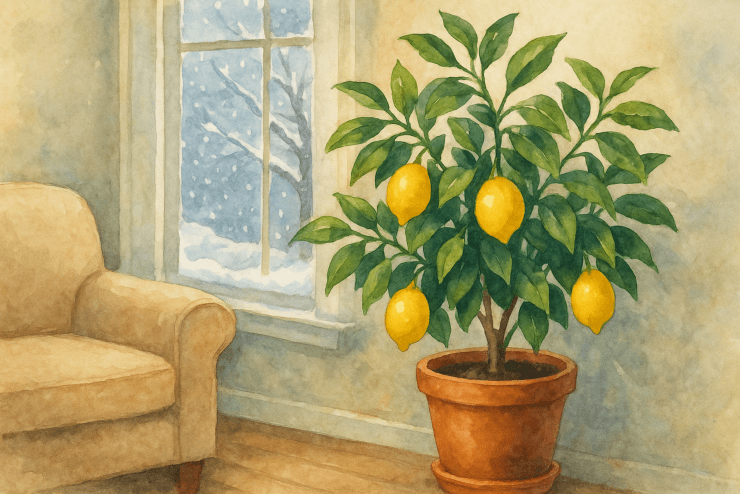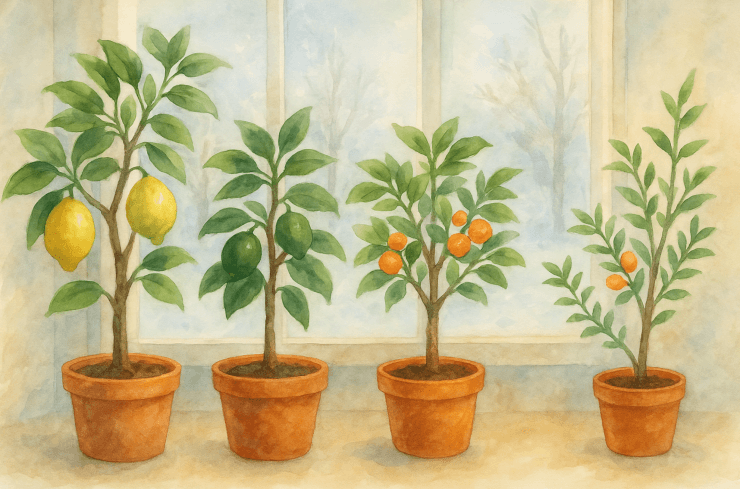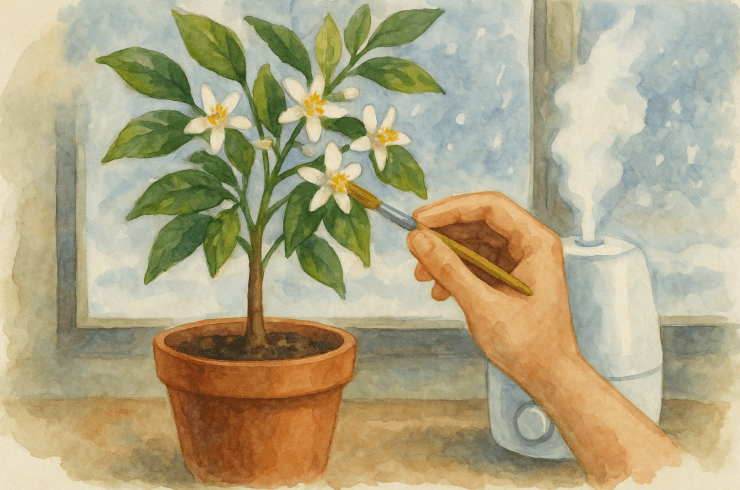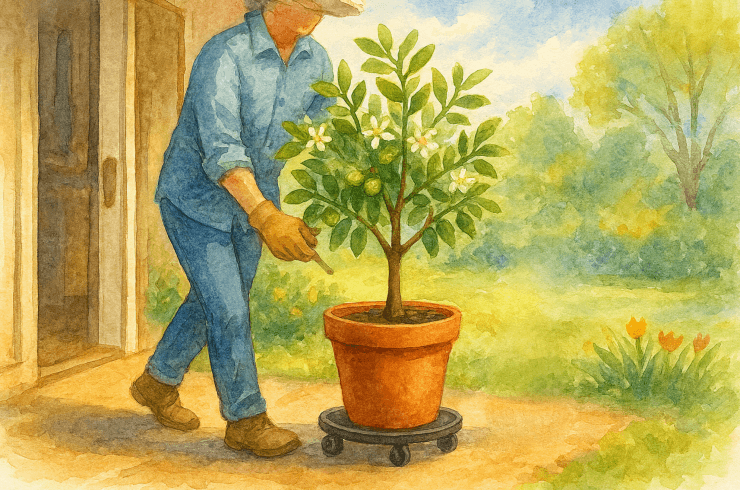Read by Matilda Longbottom

I know you’ve always imagined it: snow is piling up outside your window, the heating bill is climbing, and you’re already dreaming of Spring. Then you walk into your living room and pluck a perfectly ripe Meyer lemon from a tree that’s been happily growing next to your couch all Winter long. Sound too good to be true? It’s not only possible–it’s easier than you think.
I’ve spent years growing lemons and lime trees indoors, and I feel like I’ve been through every up and down possible when it comes to citrus trees – they’re quite prone to pests and leaf drop (more on that later!) But while your neighbors are buying expensive, shipped-from-afar citrus at the grocery store, you could be harvesting your own backyard sunshine, right from your indoor garden. For anyone living in USDA zones 8 and below, where Jack Frost makes outdoor citrus growing impossible, bringing these fragrant, fruit-bearing trees indoors isn’t just a gardening hack–it’s a Winter survival strategy that happens to smell amazing and taste even better.
The Indoor Citrus Advantage
Most citrus trees are surprisingly well-suited to container growing, making them ideal candidates for indoor cultivation. In colder climates, many gardeners adopt a “seasonal migration” approach, keeping their citrus trees outdoors during warm months and bringing them inside before the first frost threatens. This strategy allows trees to benefit from natural sunlight and rain during the growing season while staying safe from Winter’s harsh conditions.

Choosing the Right Varieties
Not all citrus trees are created equal when it comes to indoor growing. Dwarf and compact varieties are your best bet, as they’ll remain manageable in containers while still producing abundant fruit. Meyer lemons top the list of indoor favorites, prized for their compact growth habit, prolific flowering, and sweet, thin-skinned fruit that ripens reliably indoors. Their flowers are also wonderfully fragrant, filling your home with a delightful citrus perfume.
Key lime trees are another excellent choice, staying naturally small while producing the tart, aromatic limes essential for authentic key lime pie. Calamondin oranges offer ornamental appeal with their small, decorative fruit and tolerance for lower light conditions. For something unique, consider kumquats, which produce small, entirely edible fruit and adapt well to container life.
Blood oranges, mandarins, and grapefruits can work indoors if you choose dwarf rootstock varieties, though they typically require more space and stronger light to fruit successfully.
Essential Growing Conditions
Light is the most critical factor for indoor citrus success. These sun-loving plants need at least 6–8 hours of bright light daily. A south-facing window often provides the best natural light, but even then, you may need to supplement with LED grow lights during Winter months when daylight hours are limited.
Temperature control matters too. Citrus trees prefer daytime temperatures between 65–75°F and nighttime temperatures around 55–65°F. They can tolerate brief dips to about 50°F but will suffer damage below 40°F. Keep them away from heating vents and cold drafts.
Humidity becomes crucial in heated indoor spaces. Winter air is notoriously dry, but citrus trees prefer humidity levels around 40–50%. Use humidity trays filled with pebbles and water, group plants together, or run a humidifier to maintain adequate moisture levels.

The Pollination Question
Here’s the good news: most citrus trees are self-pollinating, meaning you don’t need multiple trees or hand pollination to get fruit. The flowers contain both male and female parts and can set fruit on their own. However, hand pollination can improve fruit set, especially for indoor trees that don’t have access to wind or beneficial insects.
If you want to hand pollinate, it’s simple: use a small, soft brush to transfer pollen from the center of one flower to another, or gently shake flowering branches to distribute pollen naturally. Some growers find that lightly tapping or vibrating branches during peak flowering mimics the natural movement that would occur outdoors.
Seasonal Care and Transitions
- Spring marks the time to gradually reintroduce outdoor trees to external conditions. Start by placing them in a protected, partially shaded location for a few hours daily, gradually increasing exposure over a week or two to prevent shock.
- Summer outdoor care should focus on consistent watering and monthly feeding with citrus-specific fertilizer. Keep containers on wheels or dollies to make the eventual indoor transition easier.
- Fall preparation begins when nighttime temperatures start dipping toward 50°F. Inspect trees carefully for pests before bringing them inside, and quarantine new or returning plants for a week to prevent introducing problems to your indoor garden.

Winter Care Success
Indoor Winter care requires attention to watering practices. Container citrus needs consistent moisture but never waterlogged conditions. Check soil regularly and water when the top inch feels dry. Fertilizing should continue but at reduced frequency – monthly feeding with diluted citrus fertilizer keeps trees healthy without promoting excessive growth in lower light conditions.
Pruning during Winter months helps maintain manageable size and promotes good air circulation. Remove any dead, damaged, or crossing branches, and pinch back vigorous growth to maintain shape.
Troubleshooting Common Issues
As a northeastern citrus tree grower and tryer-outer, I can tell you that growing them indoors is not a set-and-forget-it kind of relationship. Leaf drop often occurs during the transition indoors and usually stabilizes once trees adjust. Scale insects and spider mites thrive in dry indoor conditions, so maintain humidity and inspect plants regularly. Yellowing leaves typically indicate overwatering or nutrient deficiencies. And if you’re introducing a new citrus plant to a home with healthy ones, be diligent in looking for pests under the leaves, and tiny spider mite webs – they can quickly kill your new plants and your healthy ones!
But with proper care and variety selection, indoor citrus trees can thrive for years, providing not just fresh fruit but also natural air purification, beautiful fragrance, and a daily reminder that Spring will return. There’s something magical about picking a fresh lemon from your own tree while snow falls outside – a perfect blend of gardening satisfaction and Winter comfort that’ll have you wondering why you didn’t start your indoor citrus grove years ago.
What are your tricks for keeping citrus alive in cooler climates over Winter? ❖


 Previous
Previous


